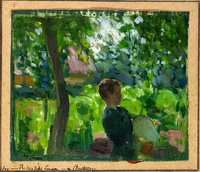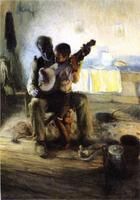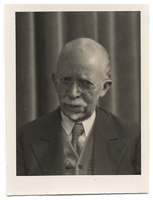Items
Tag
Henry Ossawa Tanner
-
 The Bagpipe Lesson This study shows a boy practicing the bagpipe, but for the final version, Henry Ossawa Tanner added a teacher and two more figures. Bagpipe players were common in the French region of Pont-Aven and Concarneau, where Tanner spent his summers in the 1890s. Here, he used bold colors and loose brushwork to capture the scene. Tanner entered a finished version in the annual Paris exhibition, but it was rejected; the Pennsylvania Academy of the Fine Arts, however, accepted it for their yearly show. (Smithsonian Collections Search Center)
The Bagpipe Lesson This study shows a boy practicing the bagpipe, but for the final version, Henry Ossawa Tanner added a teacher and two more figures. Bagpipe players were common in the French region of Pont-Aven and Concarneau, where Tanner spent his summers in the 1890s. Here, he used bold colors and loose brushwork to capture the scene. Tanner entered a finished version in the annual Paris exhibition, but it was rejected; the Pennsylvania Academy of the Fine Arts, however, accepted it for their yearly show. (Smithsonian Collections Search Center) -
 The Banjo Lesson
The Banjo Lesson
-
 Henry Ossawa Tanner The most distinguished African-American artist of the nineteenth century, Henry Ossawa Tanner was also the first artist of his race to achieve international acclaim. Tanner was born on June 21, 1859, in Pittsburgh, Pennsylvania, to Benjamin Tucker and Sarah Miller Tanner. Tanner's father was a college-educated teacher and minister who later became a bishop in the African Methodist Episcopalian Church. Sarah Tanner was a former slave whose mother had sent her north to Pittsburgh through the Underground Railroad. Tanner's family moved frequently during his early years when his father was assigned to various churches and schools. In 1864 Tanner's family settled in Philadelphia where his early artistic interests were developed. At age thirteen, Tanner decided to become an artist when he saw a painter at work during a walk in Fairmount Park near his home. Throughout his teens, Tanner painted and drew constantly in his spare time and tried to look at art as much as possible in Philadelphia art galleries. He also studied briefly with two of the city's minor painters. (Smithsonian Museum of American Art)
Henry Ossawa Tanner The most distinguished African-American artist of the nineteenth century, Henry Ossawa Tanner was also the first artist of his race to achieve international acclaim. Tanner was born on June 21, 1859, in Pittsburgh, Pennsylvania, to Benjamin Tucker and Sarah Miller Tanner. Tanner's father was a college-educated teacher and minister who later became a bishop in the African Methodist Episcopalian Church. Sarah Tanner was a former slave whose mother had sent her north to Pittsburgh through the Underground Railroad. Tanner's family moved frequently during his early years when his father was assigned to various churches and schools. In 1864 Tanner's family settled in Philadelphia where his early artistic interests were developed. At age thirteen, Tanner decided to become an artist when he saw a painter at work during a walk in Fairmount Park near his home. Throughout his teens, Tanner painted and drew constantly in his spare time and tried to look at art as much as possible in Philadelphia art galleries. He also studied briefly with two of the city's minor painters. (Smithsonian Museum of American Art)